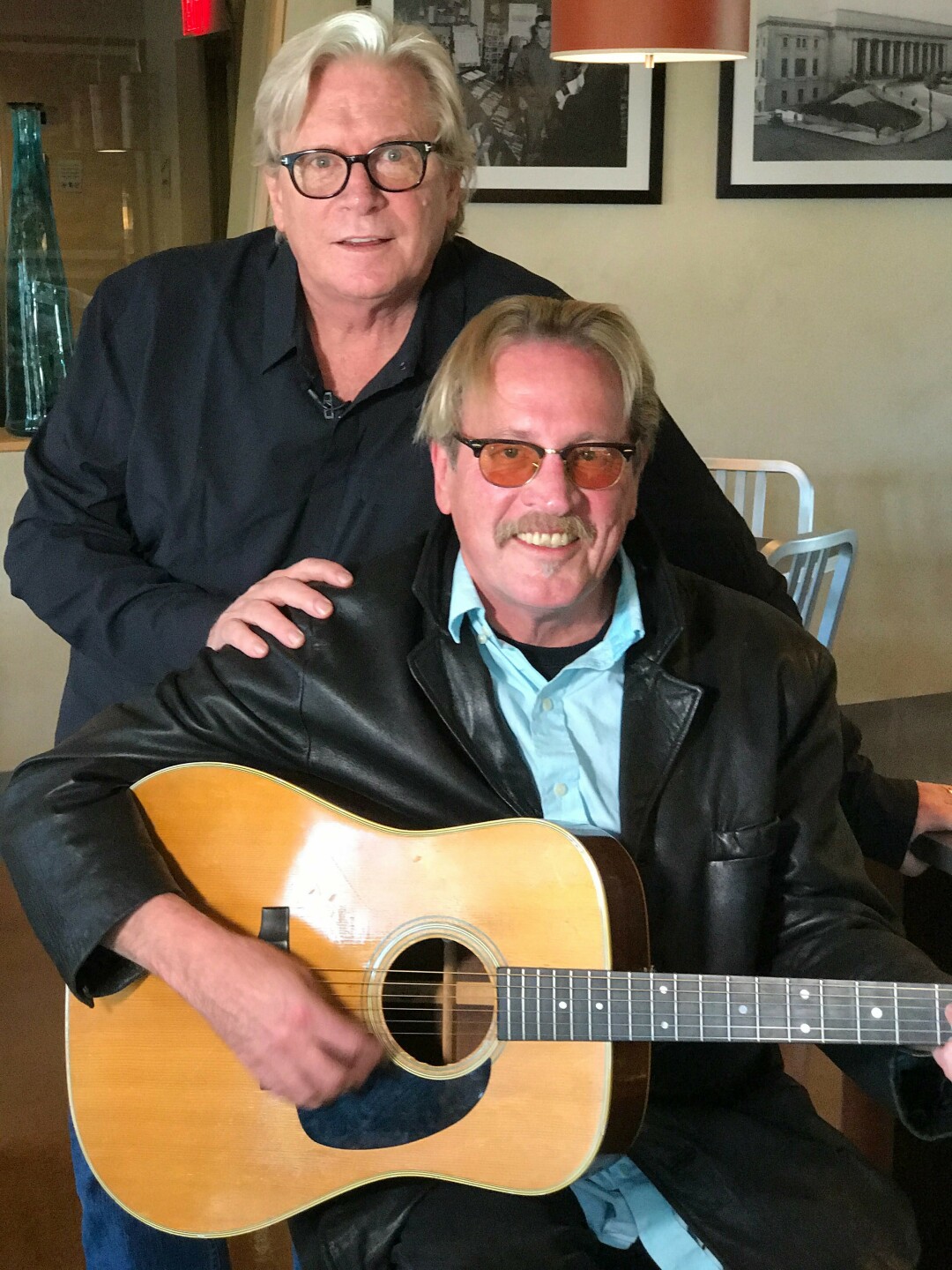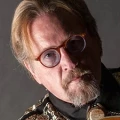News & Articles
Browse all content by date.

Kevin Odegard and Paul Metsa with the 1969 Martin-D 28 that Odegard played on "Tangled Up in Blue." Photo by Sean Skinner.
I had no idea when I conceived and presented the Million Dollar Bash, a celebration of Bob Dylan's 60th birthday on May 23, 2001, at First Avenue in Minneapolis that it would restart the effort to finally get acknowledgement for the six Minnesota musicians who performed on Dylan's Blood on the Tracks. That night we had more than 40 acts participating along with 5 of the 6 members of the Mpls. Blood on the Tracks band, the first time they performed together since those recording sessions in 1974. When the record was released in 1975, the Minnesota musicians names didn't appear on the record as the album cover had already been printed before Dylan re-recorded 5 of the songs in Minneapolis. So the cover included the NYC musicians who recorded those songs in September of 1974 but none of the musicians who played on the Minnesota sessions. They finally received long overdue credit in 2018 with the release of the 6 disc set More Blood, More Tracks.
Our book, Blood in the Tracks: The Minnesota Musicians Behind Dylan's Masterpiece, tells not only that story but the stories of those 6 musicians before, during, and after those sessions. But I'd like to take you back to that magical night of the Million Dollar Bash 22 years ago.
(In 2001, I organized and help promote a 60th Birthday Tribute to Bob Dylan at First Avenue in Minneapolis. I wrote an article for On the Tracks, a quarterly Dylan fan magazine out of Colorado. This is an excerpt from that article.)
This was almost going to be about Istanbul. Sometime in the March of 2001 I received an e-mail inviting me to play at a Bob Dylan Birthday Tribute at a Horse Farm in Turkey. Say what you will about the modern Jewish troubadour, but admit that after 1959 when he left the front door of his two-story stucco house in Hibbing, he began to write songs-louder than gunshots yet heard clear as a bell-that were heard the whole world ‘round.
I grew up in Virginia, Minnesota, on the Iron Range (21 miles from Hibbing.) One Saturday afternoon while in second grade I snuck downtown and saw Elvis at the World’s Fair at the Maco Theater and my life was forever changed. Elvis played guitar, drove nice cars, hung out with beautiful women. With all due respect to Harmon Killebrew, the Minnesota Twins homerun king, I now had another role model worth emulating.
I begged my folks for a Sears Silvertone guitar with a cowboy and horse stenciled on the front and with that, was on my way. Dylan on the radio in 1965 was like a Buck Rogers laser shot. Mama was in the basement mixing up the medicine and the rest of us walked the shadow streets of this New America seduced and enchanted by these new wild and mercury sounds. Those sounds changed my life, your life and how America viewed itself.
When I got old enough to hitch-hike, I’d catch a ride to Hibbing and stand in front of this house and wonder what ghosts haunted Bobby Zimmerman and turned him into Bob Dylan. Good for those ghosts, I say. Although an all-expenses-paid trip to Istanbul to play Dylan tunes, and some of my own, to the Turkish faithful of His Bobness sounded like a hallucination worth having, I reconsidered.
Two martinis and a half a pack of Lucky Strikes later, it seemed obvious that Minneapolis owed its favorite folkie son a birthday tribute of the highest and swingingest order. The “Million Dollar Bash," a Minneapolis rock and Roll Hootenanny Tribute Show to Minnesota’s hippest soon-to-be 60 rockin’ cat daddy and native son was informally underway.
The first call I made when I got home was to Kevin Odegard. Odegard was one of the guitarists on Dylan’s Blood on the Tracks, and had boldly suggested to Dylan that he change the key of "Simple Twist of Fate" from the key of G to the key of A, which he did. I have suggested to Odegard since, that should go on his tombstone. May we all have such moments in these mysterious lives of ours.
I asked him if it was possible to get the boys back together from those sessions (including Bob Berg-drums, Gregg Inhofer-keys, Chris Weber-guitar, and Billy Peterson-bass) for one set. They had not played together since those magical sessions in Minneapolis in 1974. Odegard was on it like cigarette burns on Keith Richards Telecaster.
I had to leave for NYC in a few days and was looking forward to a gig at the Mercury Lounge on the Lower East Side and at the Stone Pony in Asbury Park, the former stomping grounds of Bruce Springsteen and others. While in NYC a Vanity Fair article came out with an excerpt from a book by David Hadju about the early '60s folk scene in Greenwich Village. While reading it, I realized that is was also the 40th Anniversary of Dylan’s debut in Folk City. The flag of history was waving wildly.
I also spent an afternoon with my friend Tony “Tilt” Rubin at the Woody Guthrie Archives on 57th Street in the august company of Harold Leventhal (Woody Guthrie’s manager who presented a young Bob Dylan at Carnegie Hall) Fred Hellerman, one of the original members of the Weavers, and my friend Nora Guthrie (Woody’s daughter), who was in the process of putting Woody’s vast archives together.
And for those of you that don’t know – No Woody Guthrie, No Bob Dylan, and it really is as simple as that.
When I got back to Minneapolis I called Odegard, who told me everyone from the Blood on the Tracks sessions (now referred to as BOTT) was available with the exception of Bill Berg, drummer and also a Hibbing native. The concert was going to be Wednesday, May 23, the night before Dylan’s actual birthday on the 24th.
I suddenly realized May 23rd was also the seventh anniversary of my mother’s death. Let her ghost and spirit guide me.
After several days of rehearsal, and along with First Avenue, one of the world’s premiere music venues, contacting and book 40 other bands for the show, the concert was finally approaching. The show started at 8 pm with Hugh Brown (one of Dylan’s first roomates in Dinkytown) reading Dylan’s “Last Thoughts on Woody Guthrie” (now repeat after me, No Woody, No Bob.)
Dave Morton, an early influence on Dylan, arrived on stage in a Hibbing baseball cap and proved he is the missing link between Jed Clampett and Salvador Dali.
I also read a message from LeRoy Hoikkala, Dylan’s first drummer from the Gold Chords, wishing us all the best.
The place was starting to fill and some of the finest musicians in Minneapolis played, with inspiration and panache, choice covers for the old and new testament of America’s greatest living songwriter. The scene backstage was equally engaging: Cowboy hats and dreadlocks, spiked hair and long flowing curls on top of heads that had been turned around, from the Lincoln County Line to Tinseltown, in leather pants and weddings gowns, nodding in unison to what each other had played or would be playing. And all silently agreeing with Paul Cebar, Milwaukee’s finest musician, who put it so succinctly and spoke for these diamond-studded musical vagabonds, drifters and dreamers, and back alley poets, when he said, “Dylan, he ruined us all.”
It was a carnival, a revival meeting, a hipsters prom, a séance, a street dance, a poetry reading and rock and roll hootenanny shaken and stirred into one glorious night. At 11 p.m. I introduced the Blood on the Tracks band. Listening to the opening salvo of “Idiot Wind” was like watching five prizefighters going for a knockout in the first round. “You’re a Big Girl Now” shone with the glow of thousands of midnight fireflies. By the end of “Tangled Up in Blue,” the house now 1,000 people strong was swaying in unison and shaking like a mighty train bound for glory.
Dave Morton grabbed a tambourine, hopped up on stage and joined them, completing the circle from 1959 to 1974, all right here near midnight in 2001. The midnight hour was now upon us and no way out for either the joker or the thief. The bands played louder, the crowd dancing like the beach movie of your dreams, Dylan’s words and melodies crashing against the walls like an unstoppable Holy Grail, through the roof and to the skies, in jungle rhythms of the damned and newly sainted in star-dappled circles from his hometown, this night, to the world.
With crimson flames tied through my ears on a high and mighty trap, I played “MY Back Pages” with Billy, Peter and Gregg, dedicated it to Ma, and led the thousand-voice Mill City Choir in the smoke-filled, whisky-drenched campfire chorus: “I was so much older then, I am younger than that now.”
Highway 61 now ran right through the center of town. Six hours, 40 acts and 70-some songs later, the show closed with the grand finale, a sacred circle with Bob’s musical messengers, those pilgrims tough enough to still be standing and the rock and roll prayer, “I Shall Be Released.” I was and we were.
Paul Metsa is a musician, songwriter and author who lives in Lincoln Park.
Paul Metsa and Rick Shefchik will be at Zenith Bookstore for the Duluth launch of their book "Blood in the Tracks: The Minnesota Musicians Behind Dylan's Masterpiece " Thursday, Sept. 14, 7 - 8:30 p.m.
| Tweet |


